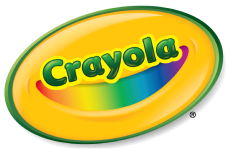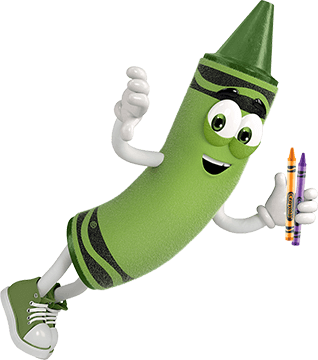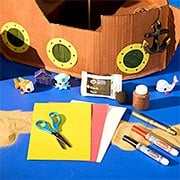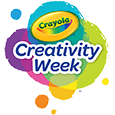Crayola® no inventó el crayón. El crayón "moderno" se originó en Europa, inicialmente hecho de una mezcla de carbón y aceite, luego reemplazado por pigmentos en polvo. Más tarde, la cera fue sustituida por el aceite, lo que hizo que los palos fueran más resistentes y fáciles de manejar.
En 1902, los lápices de colores Crayola fueron inventados por Binney & Smith y se pusieron a la venta por primera vez en 1903. El nombre comercial "Crayola" fue acuñado por la Sra. Edwin Binney, combinando "craie" (palo de tiza en francés) y "oleaginous" (aceitoso).
Crayola fabrica más de 3 mil millones de crayones cada año, hechos principalmente de cera de parafina y pigmento de color. Obtenga más información sobre la colorida historia de Crayola en la página de historia de Crayola.
Si tienes preguntas adicionales, ¡nos encantaría saber de ti! No dudes en llamarnos o enviarnos un mensaje de texto al 1-800-CRAYOLA días laborables entre las 9 AM y las 4 PM hora del Este. Si prefieres enviarnos un correo electrónico, visita nuestra página de contacto.
Preguntas relacionadas
Explora respuestas a preguntas comunes, consejos útiles para eliminar manchas e ideas creativas para aprovechar al máximo nuestros materiales de arte y recursos gratuitos.
-
Crayola® Crayons are made using primarily paraffin wax and color pigment. While the basic ingredients remain consistent across all colors, variations may occur in special effects crayons.
Our crayons are crafted through a process that involves melting paraffin wax and blending it with color pigments. This mixture is then poured into molding machines where it solidifies in four to seven minutes. For a behind-the-scenes look at the Crayola crayon manufacturing process, watch the video "You've Got Crayola Crayons" on YouTube.
-
The basic ingredients contained in Crayola® Crayons are paraffin wax and color pigment. These ingredients are the same for all Crayola Crayon colors, with some modifications in special effects crayons.
Crayola Crayons begin to melt at around 105° Fahrenheit and have a melting point between 120° - 147° Fahrenheit. The melting point is the same for all regular Crayola Crayons; however, the density and amount of pigment included in different crayons will result in varying thickness or viscosity of the mixture.
-
Throughout Crayola's history, several crayon colors have been retired, marking significant moments in the evolution of our vibrant palette.
1990
For the first time in Crayola history, eight colors were retired and placed in the Crayola Hall of Fame: blue gray, green blue, lemon yellow, maize, orange red, orange yellow, raw umber, and violet blue. Eight new colors were added: cerulean, dandelion, fuchsia, jungle green, royal purple, teal blue, vivid tangerine, and wild strawberry.2003
Celebrating a century of bringing color to the world, Crayola introduced four new colors named by Crayola fans! To make room for the new hues, we bid farewell to blizzard blue, magic mint, mulberry, and teal blue. The four new colors that were introduced are: inchworm, jazzberry jam, mango tango, and wild blue yonder. Kudos to our hue heroes - the consumers who voted in the "Save the Shade" campaign, ensuring burnt sienna stayed in the pack.2017
To mark National Crayon Day on March 31st, we announced Dandelion was leaving the pack. To honor this iconic color, we sent Dandelion on a retirement tour to his favorite places. His replacement, Bluetiful, was announced on May 5, 2017.Looking for more historical facts about our colorful company? We've got them on the Crayola History page!
-
The first part of the Crayola Crayon color name is an adjective describing the second color name on the crayon. Green-blue is really blue with a touch of green, while blue-green is really green with some blue pigment in the crayon. The same holds true for orange-red and red-orange.
-
Before Crayola® Crayons were introduced, we produced black marking crayons in 1900. These early crayons, made with dry carbon black and various waxes, are now known as Staonal® Marking Crayons, widely used in industrial settings.
Recognizing a need in schools for safe and affordable wax crayons, Binney & Smith created the first box of eight Crayola Crayons in 1903. Sold for a nickel, this box included red, orange, yellow, green, blue, violet, brown, and black. The Crayola name was coined by Alice Binney, wife of company founder Edwin Binney and a former schoolteacher. It combines the French word for "chalk" ("craie") with "ola," meaning "oily."
Want to know more about our colorful history? Check out the details at Crayola.com.




